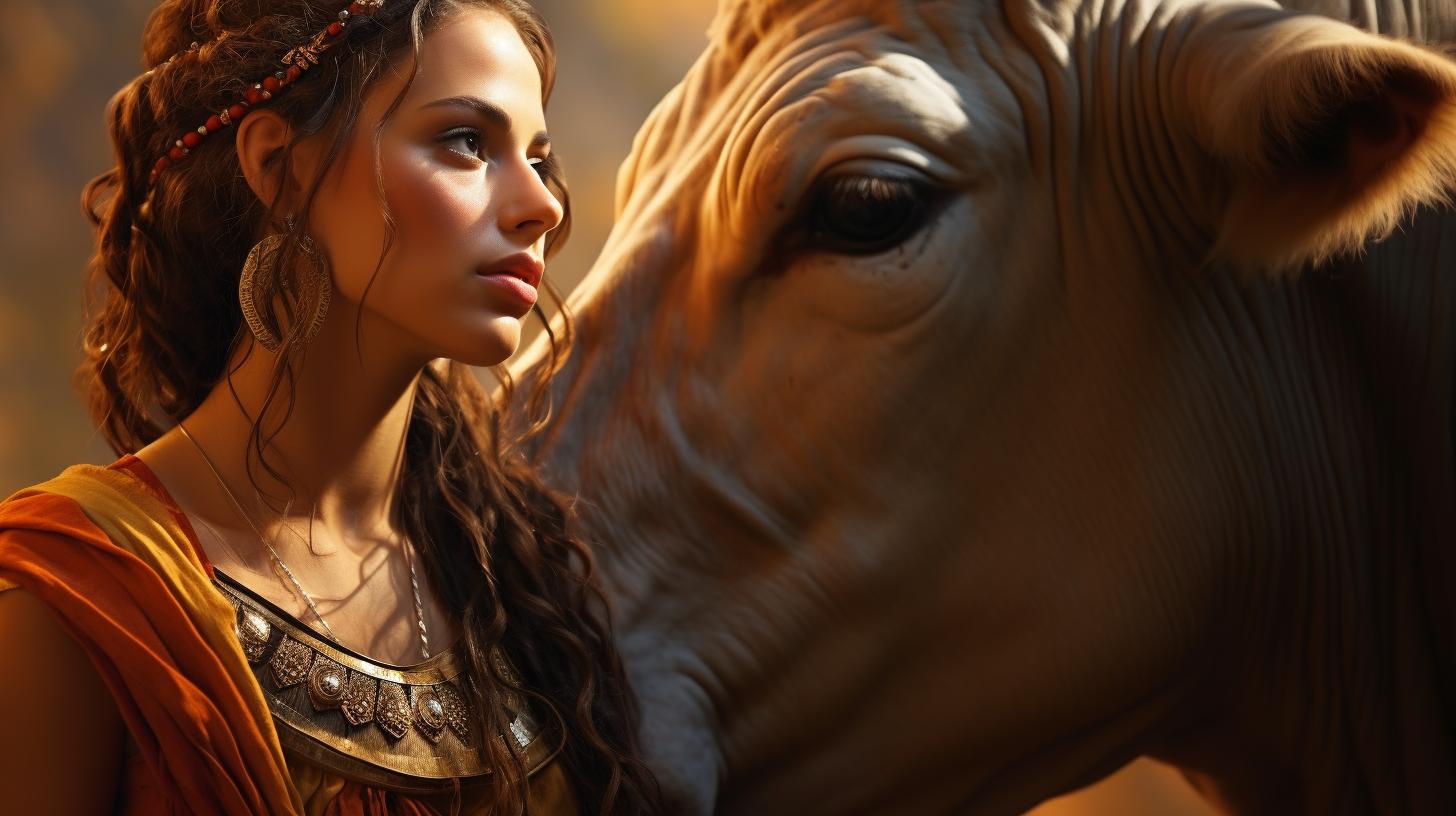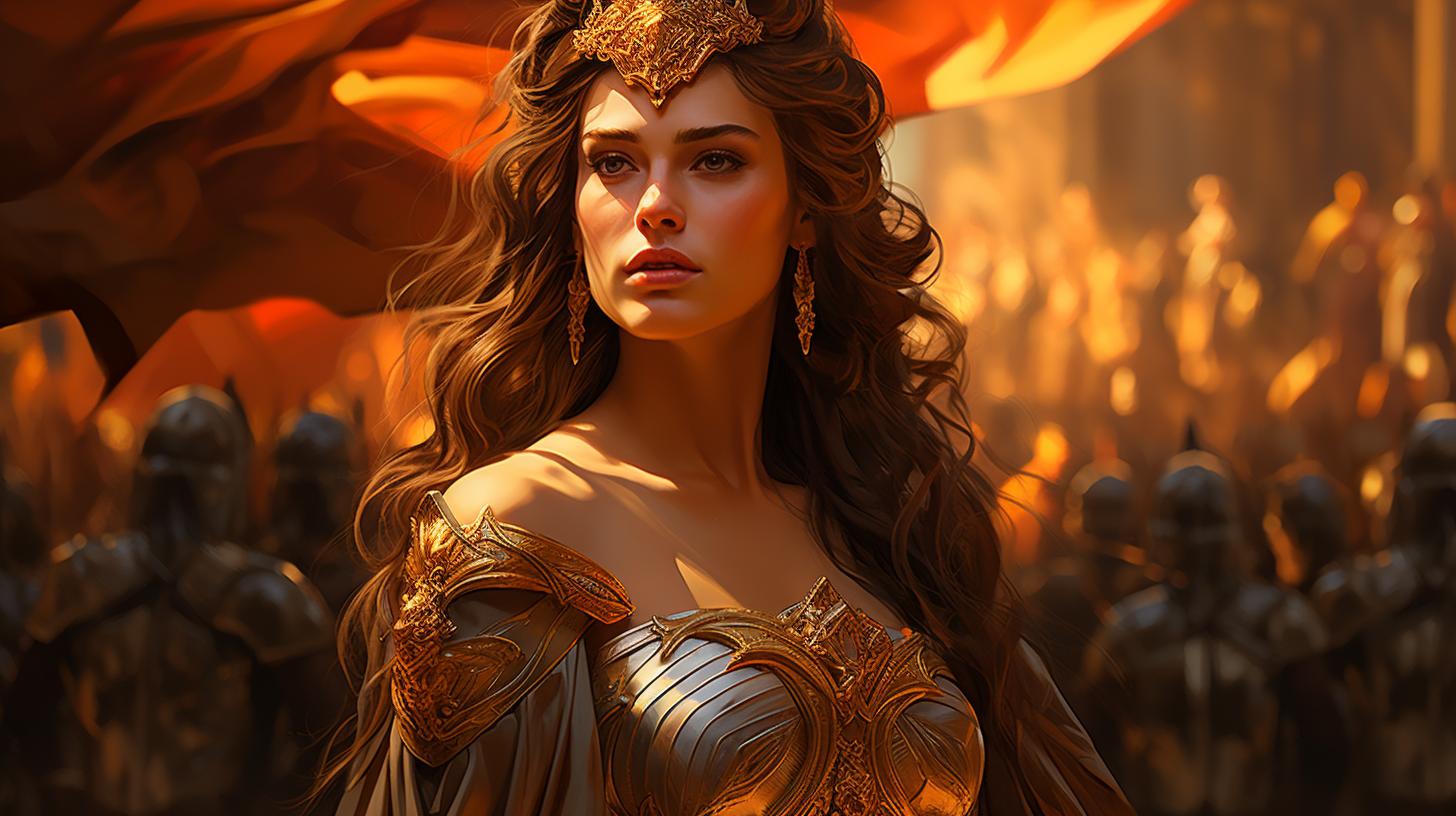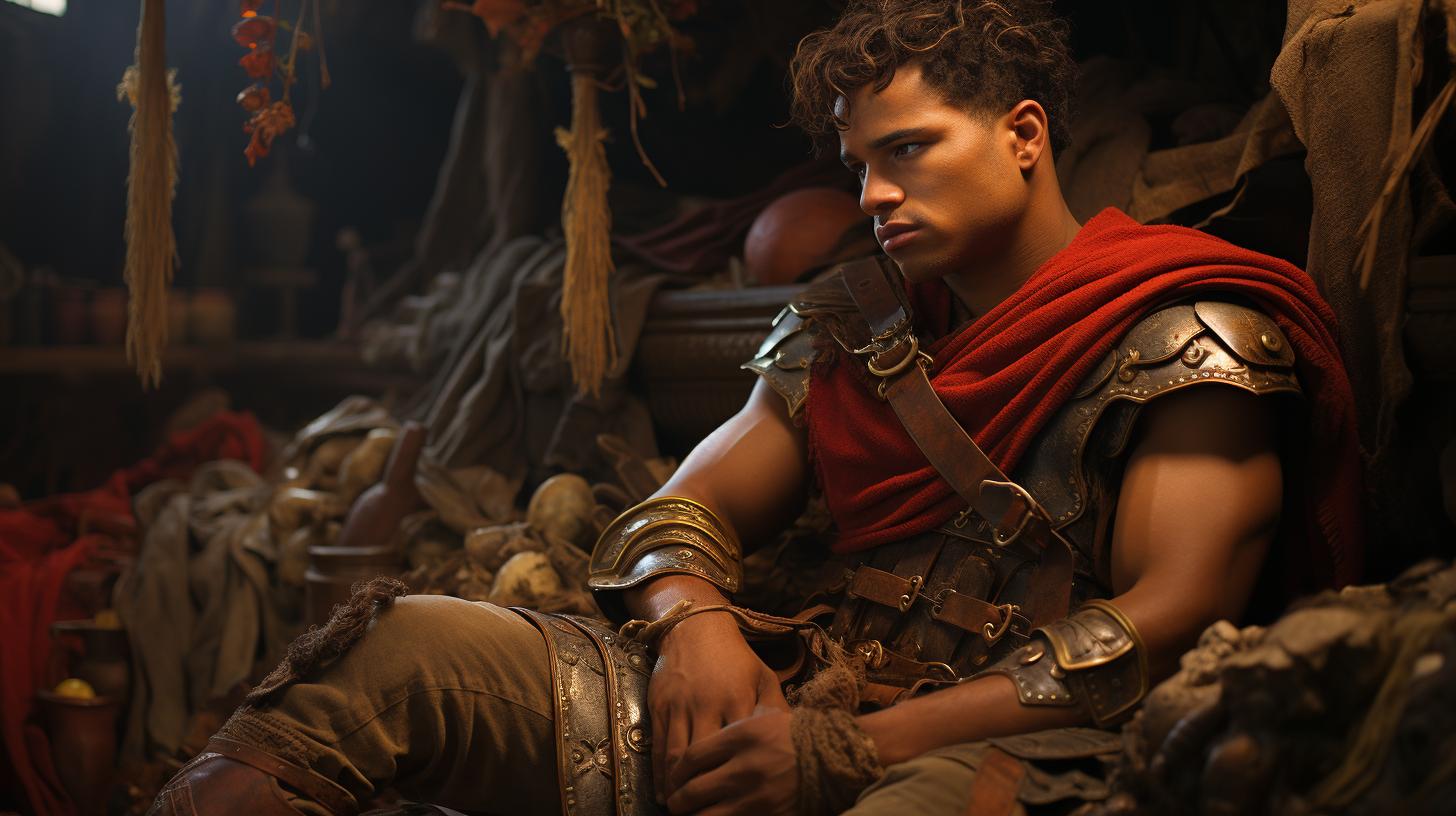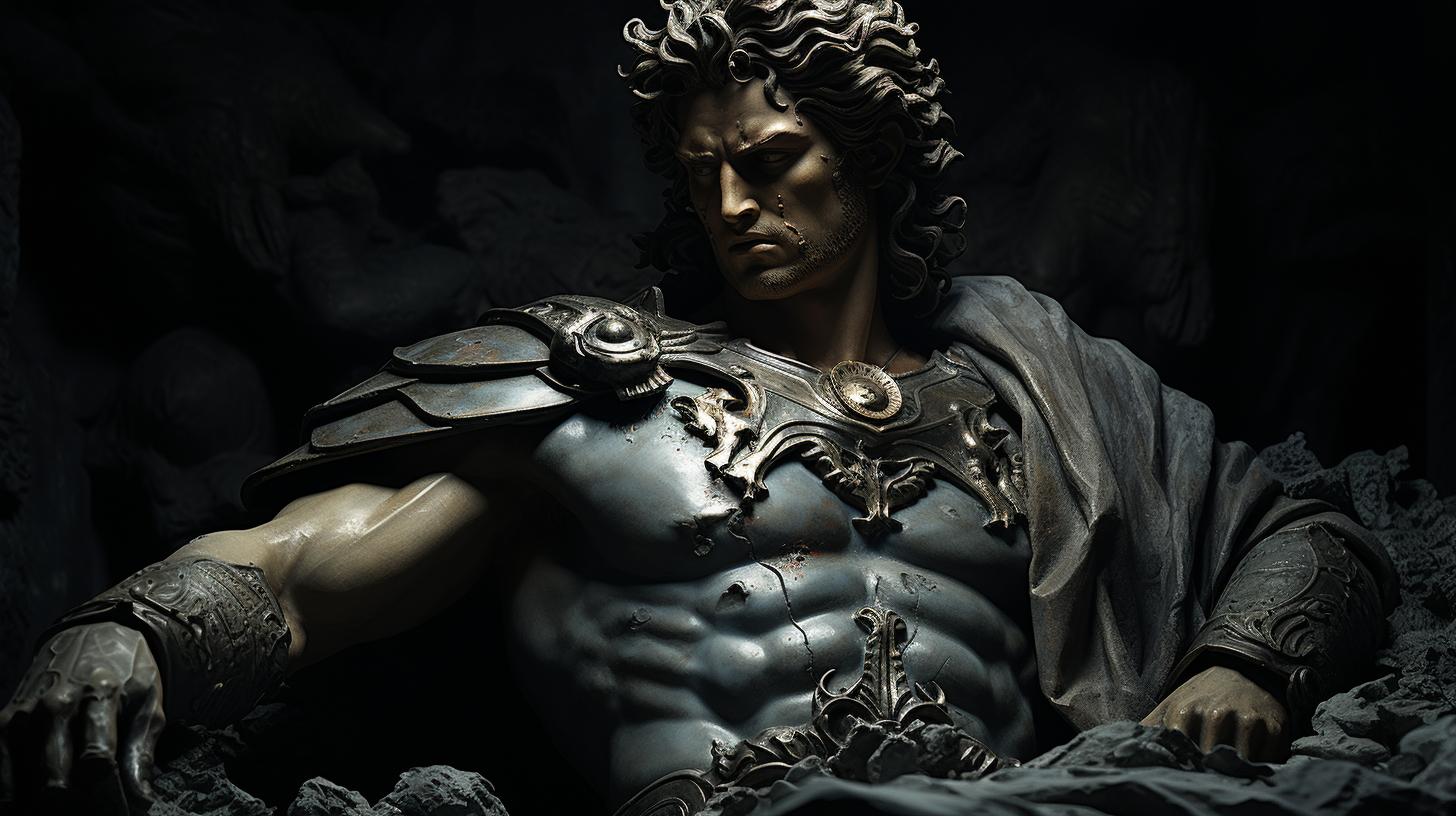Unraveling the Intriguing Tale of Pasiphae in Greek Mythology

Pasiphae, an important figure in Greek mythology, was the daughter of the sun god Helios and Perseis. Married to the legendary king Minos of Crete, she had several children, including the Minotaur. Infidelity and curses plagued Pasiphae’s life, but she also held roles as a lunar goddess and oracle in Thalamae.
This article explores the fascinating tales of Pasiphae in Greek mythology, from her marital struggles to her connection with the labyrinth and her portrayal in art and literature. Find answers to frequently asked questions about Pasiphae’s intriguing legacy.
The Mythological Origins of Pasiphae
In Greek mythology, Pasiphae holds a significant place as a captivating figure. She is believed to be the daughter of the god of the sun, Helios, and Perseis.
Pasiphae’s origins tie her lineage to divine parentage, which adds to her mythical allure.
According to the legends, Pasiphae’s life took a dark turn when she incurred the wrath of the gods, resulting in a curse that bestowed upon her an insatiable desire for the most beautiful bull owned by her husband, King Minos of Crete.
The exact offense that led to this curse remains unknown, but its consequences shaped the course of Pasiphae’s tale.
To fulfill her forbidden desire, Pasiphae turned to the skilled craftsman Daedalus for assistance. Daedalus constructed an animated wooden cow wrapped in bovine hide, which Pasiphae concealed herself inside.
By this unconventional means, she managed to unite with the magnificent bull and conceive a hybrid offspring: the fearsome Minotaur, with the head of a bull and the body of a man.
The mythological origins of Pasiphae showcase the complexities and intriguing aspects of Greek mythology. Her divine lineage, curse, and extraordinary union with the bull illuminate the enthralling nature of her story.
Through exploration of Pasiphae’s origins, we gain insight into the multifaceted world of Greek mythology, its intricate characters, and the rich tapestry of tales that have been passed down through generations.
The Marriage of Pasiphae and Minos
In Greek mythology, Pasiphae, the daughter of Helios and Perseis, was married to the legendary King Minos of Crete. Their union was marked by both love and turmoil, as they navigated the challenges of ruling a kingdom and facing the wrath of the gods.
Pasiphae and Minos sought to establish a prosperous reign in Crete, and together they had a profound impact on the island’s history. Their marriage was not without its complications, however, as both Pasiphae and Minos experienced moments of infidelity and betrayal.
Despite their trials, Pasiphae and Minos managed to maintain their bond and fulfill their roles as rulers of Crete. They worked together to govern the kingdom, making important decisions and shaping the destiny of their people.
While their marriage was not devoid of challenges, the partnership between Pasiphae and Minos played a significant role in the mythological narratives of ancient Greece. Their story serves as a reminder of the complexities and dynamics that exist within relationships, even those involving deities and mortals.
As the tale of Pasiphae and Minos unfolds, we gain insights into the power dynamics, struggles, and enduring love that characterized their marital journey. It is through their marriage that we come to understand the profound impact they had on each other’s lives and the mythology of ancient Greece.
Pasiphae’s Sons: Androgeus, Catreus, Deucalion, and Glauco
In addition to the infamous Minotaur, Pasiphae, the daughter of Helios and Perseis, also bore other sons during her marriage to King Minos of Crete. These sons played significant roles in Greek mythology, each with their own stories and destinies.
Androgeus
Androgeus, one of Pasiphae’s sons, was a renowned athlete and warrior. He participated in the Panathenaic Games in Athens and won numerous victories. However, his fame stirred jealousy and led to his untimely demise.
After winning an athletic competition in Attica, Androgeus was murdered by jealous rivals, sparking a series of events that eventually led to Athens being subjected to Minos’ wrath.
Catreus
Catreus, another son of Pasiphae, was known for his wisdom and just rule. He became the king of Crete after Minos, and his reign was marked by peace and prosperity.
However, his life ended tragically when he was inadvertently killed by his own son, Althaemenes, during a hunting accident. This unfortunate incident left a lasting impact on the kingdom of Crete.
Deucalion
Deucalion, another of Pasiphae’s sons, was known for his bravery and leadership. He played a significant role in the Trojan War, fighting alongside other Greek heroes. Deucalion was respected for his military prowess and his loyalty to his allies.
His courageous deeds and strategic skills earned him a place among the esteemed warriors of Greek mythology.
Glauco
Glauco, the fourth son of Pasiphae, was a wise and respected ruler. He became the king of Corinth after his brother Catreus and was known for his fairness and diplomacy. Glauco played a crucial role in maintaining peace and fostering alliances between different Greek city-states.
His legacy as a just and capable leader was remembered long after his passing.
These sons of Pasiphae, Androgeus, Catreus, Deucalion, and Glauco, each contributed to the expansive tapestry of Greek mythology, leaving behind a lasting impact as brave warriors, wise rulers, and tragic figures.
Their stories continue to captivate and inspire individuals to this day.
Pasiphae’s Daughters: Acalle, Xenodice, Ariadne, and Phaedra
Pasiphae, the legendary wife of King Minos of Crete, bore several notable daughters who played significant roles in Greek mythology. Acalle, Xenodice, Ariadne, and Phaedra each had unique tales intertwined with their mother’s captivating story.
- Acallee: Known for her beauty and grace, Acalle was revered as a nymph in some accounts. Her enchanting presence and connection to the natural world added depth to the mythology surrounding Pasiphae and her lineage.
- Xenodice: As the daughter of Pasiphae, Xenodice’s significance lies in her ties to the royal family of Crete.
While her individual mythology may not be as widely documented as her sisters’, her existence bolsters the intricate web of stories surrounding Pasiphae and her descendants.
- Ariadne: Perhaps the most famous of Pasiphae’s daughters, Ariadne played a pivotal role in the tale of Theseus and the Minotaur. Her assistance, offering him a ball of thread to navigate the labyrinth and defeat the Minotaur, showcased her ingenuity and resourcefulness.
Ariadne’s story extends beyond this myth, as she later became the wife of the god Dionysus, solidifying her place among the Greek pantheon.
- Phaedra: Often regarded as the tragic figure in this family lineage, Phaedra’s story is entwined with themes of forbidden love and betrayal.
Her ill-fated romantic entanglement with her stepson, Hippolytus, resulted in tragedy and untimely death for both. Phaedra’s complex narrative serves as a reminder of the complexities and consequences of love and desire.
These daughters of Pasiphae contribute to the rich tapestry of Greek mythology, each bringing their unique characteristics and stories that echo through the annals of history.
Pasiphae’s Unnatural Love: The Myth of the Minotaur
In Greek mythology, Pasiphae’s story takes a dark turn with her unnatural love for a bull, resulting in the birth of the monstrous Minotaur. It is said that Pasiphae, cursed with an insatiable desire for the king’s most beautiful bull, sought the help of the skilled craftsman Daedalus to satisfy her forbidden passion.
Daedalus ingeniously constructed a wooden cow covered in cowhide, allowing Pasiphae to hide inside and mate with the bull. This twisted union led to the conception of a horrific creature – the Minotaur, a creature with the head of a bull and the body of a man.
Minos, Pasiphae’s husband, was horrified by the birth of this abomination and ordered Daedalus to construct the Labyrinth, a complex maze, to imprison the Minotaur and prevent it from wreaking havoc on the kingdom of Crete.
The tale of Pasiphae and the Minotaur serves as a cautionary reminder of the consequences that can arise from forbidden desires and the extremes one may go to satisfy them.
It also highlights the intricate role of Daedalus in enabling Pasiphae’s forbidden love and the subsequent creation and containment of the monstrous Minotaur. This myth continues to captivate audiences and inspire artistic interpretations that explore the complex themes of desire, forbidden love, and the consequences of indulging in such passions.
The Role of Daidalos in Pasiphae’s Story
In the complex web of Pasiphae’s mythology, the figure of Daidalos, the renowned craftsman and architect, plays a significant role. Daidalos was the mastermind behind the construction of the labyrinth, the intricate maze designed to confine the fearsome Minotaur, Pasiphae’s unnatural offspring.
Daidalos, known for his exceptional creativity and ingenuity, was entrusted by King Minos with the task of creating the labyrinth. Using his exceptional architectural skills, he crafted a bewildering maze that was nearly impossible to navigate, ensuring that the Minotaur remained imprisoned within its walls.
With his expertise in crafting intricate structures, Daidalos became an instrumental figure in Pasiphae’s story. His role in designing and constructing the labyrinth not only reflected his craftsmanship but also highlighted the consequences of Pasiphae’s ill-fated union with the sacred bull.
Additionally, Daidalos played a significant role in aiding Pasiphae in her venture to satiate her desire for the magnificent bull. It was Daidalos who ingeniously constructed a lifelike wooden cow, allowing Pasiphae to conceal herself within it and fulfill her illicit desires.
The intricate involvement of Daidalos in Pasiphae’s narrative showcases his remarkable skills as an architect and his willingness to assist in fulfilling her desires. His contributions are pivotal to the development of Pasiphae’s story and the subsequent events that unfold, leading to the birth of the Minotaur and the creation of the labyrinth.
Pasiphae and Minos: Infidelity and Revenge
Pasiphae’s marriage to King Minos of Crete was not without its share of challenges and betrayals. While Pasiphae herself was cursed with an insatiable desire for the king’s most beautiful bull as a punishment for some offense committed by her or her husband against the gods, Minos was not innocent either.
It was revealed that Minos had been unfaithful to Pasiphae, engaging in infidelity with various women. Angered and hurt by his actions, Pasiphae decided to take revenge on him. She cast a powerful spell upon Minos, causing him to ejaculate venomous creatures and destroy his lovers upon sexual contact.
However, Pasiphae, being immortal, remained immune to the curse. It was only later, when a young Athenian woman named Procris devised a remedy for Minos’ affliction, that he was finally cured of this strange condition.
This tale of infidelity and revenge speaks to the complex and tumultuous nature of Pasiphae and Minos’ relationship. It showcases the consequences of their actions and the ways in which their transgressions ultimately shaped their fates.
Pasiphae as a Lunar Goddess and Oracle in Thalamae
Pasiphae, in addition to her role in the mythology surrounding the Minotaur and the labyrinth, also held significance as a lunar goddess and oracle in Thalamae. Considered a Cretan lunar deity, she was closely associated with the moon and its symbolism.
In Thalamae, located in Laconia, Pasiphae was revered as a powerful oracle. Devotees would visit her temple and sleep inside, hoping to receive divine revelations in their dreams. As a lunar goddess, she was believed to have the ability to communicate with the celestial realms and offer prophetic insights.
While various accounts suggest different origins for Pasiphae, some consider her to be the daughter of Atlas, while others associate her with Cassandra or Daphne, both daughters of Amyclas. Regardless of her lineage, she was recognized as a deity with the ability to bestow wisdom and foresight.
As an oracle, Pasiphae played a crucial role in the lives of individuals seeking guidance and insight into their future. Her temple in Thalamae became a sacred site of pilgrimage, attracting seekers of wisdom from all over the region.
The association between Pasiphae, the moon, and oracular powers aligns with ancient beliefs that connected lunar deities with prophetic abilities and intuition. The lunar cycle itself was often seen as a reflection of the cyclical nature of life, and lunar goddesses were thought to possess deep wisdom and a deeper understanding of the mysteries of the universe.
Thus, Pasiphae’s status as a lunar goddess and oracle added another layer of complexity to her character, demonstrating the multifaceted nature of her mythological presence and the significance of her role in Greek mythology.
The Connection between Pasiphae and the Labyrinth of Crete
In Greek mythology, Pasiphae’s name is closely associated with the famous labyrinth of Crete. This labyrinth was constructed by the skilled craftsman Daidalos under the command of King Minos, Pasiphae’s husband.
Its purpose was to serve as a prison for the Minotaur, the monstrous offspring of Pasiphae’s unnatural love affair with the sacred bull.
The labyrinth was an intricate maze with winding corridors and dead ends, designed to make it nearly impossible for anyone trapped inside to find their way out.
It was an elaborate structure that struck both awe and terror in those who heard of it.
Pasiphae’s connection to the labyrinth is significant because it was the birthplace and dwelling of her half-human, half-bull son, the Minotaur. This monstrous creature, born from Pasiphae’s curse, was confined within the labyrinth’s dark confines, fueling its terrifying reputation.
Legend has it that the Minotaur was fed a regular diet of human sacrifices sent from Athens as a tribute to appease King Minos. Theseus, a brave Athenian hero, eventually ventured into the labyrinth and successfully slew the fearsome Minotaur, aided by the help of Ariadne, Pasiphae’s daughter.
The intricate and enigmatic labyrinth symbolizes both the complexities of Pasiphae’s personal life and the dark secrets that were concealed within her family’s reign. It stands as a testament to Pasiphae’s role in the birth of the Minotaur and the tumultuous events that unfolded in ancient Crete.
Pasiphae’s Influence on Greek Art and Literature
Pasiphae’s intriguing myths and complex character have heavily influenced Greek art and literature throughout history. Artists and writers have often been captivated by her role as the mother of the Minotaur, as well as her unconventional love affair with a bull.
In art, Pasiphae is often depicted in sculptures, paintings, and mosaics, portraying her various roles and stories. One famous representation is her interaction with the wooden cow designed by Daidalos, a symbol of her desire for the bull.
These artistic depictions showcase the tension between Pasiphae’s human devotion and her animalistic desires.
Her story has also been the subject of numerous literary works. Playwrights like Euripides and poets like Ovid have explored Pasiphae’s struggles with forbidden love, familial relationships, and the consequences of her desires.
These works delve into the complexities of her character, revealing the emotional conflicts she faced and the tragic consequences of her actions.
Furthermore, Pasiphae’s connection to the labyrinth has been a recurring theme in Greek art and literature.
The labyrinth, constructed by Daidalos to contain the Minotaur, serves as a symbol of the psychological and emotional complexities of Pasiphae’s world. It represents the intricate and confusing nature of desires, secrets, and the consequences of one’s choices.
This motif has inspired countless interpretations in different artistic mediums.
Overall, Pasiphae’s influence in Greek art and literature stems from her fascinating and multifaceted character. Her story continues to captivate audiences, prompting reflection on themes of desire, morality, and the dark corners of human nature.
11. Unraveling the Complex Myths of Pasiphae’s Legacy
The intricate tapestry of Pasiphae’s legacy in Greek mythology is filled with captivating and multifaceted myths. Her story transcends time, weaving together themes of love, betrayal, and the supernatural.
Delving into the depths of her narrative, we encounter a wealth of intriguing tales that unveil the complexity of her character and shape her enduring influence.
One of the most well-known aspects of Pasiphae’s legacy is her connection to the labyrinth of Crete. As the mother of the fearsome Minotaur, a creature with the head of a bull and the body of a man, she played a pivotal role in its creation.
The labyrinth, a maze-like structure designed by the skilled craftsman Daedalus, served as the Minotaur’s prison and safeguarded the kingdom of Crete from his monstrous rampage.
Another prominent element of Pasiphae’s mythological heritage revolves around her tumultuous marriage to Minos, the legendary king of Crete. Their relationship was marred by infidelity and revenge. Pasiphae discovered Minos’ unfaithfulness and sought her own form of retribution, resulting in him being cursed with poisonous ejaculations.
This curse was eventually lifted by a young Athenian woman named Procris, who devised an antidote to restore his fertility.
Beyond her role in the Minotaur’s tale and her troubled marriage, Pasiphae was also revered as a lunar goddess and oracle in the sanctuary of Thalamae. Her prophetic abilities granted worshippers the opportunity to seek divine guidance through their dreams, as they slept within the sacred walls of her temple.
This mystical aspect of Pasiphae’s persona adds further depth to her enigmatic character and highlights her transcendence beyond mere mortal existence.
Throughout history, Pasiphae’s captivating story has found its place in various forms of artistic expression. From sculptures and paintings to literary works and theatrical performances, artists and writers have drawn inspiration from her complex myths.
Her portrayal showcases the enduring allure and fascination that Greek mythology holds for creative minds.
Unraveling the complex myths of Pasiphae’s legacy is a journey into a world of intricate storytelling and symbolic meaning. Her role as a mother, wife, lunar goddess, and figure of prophecy paints a vivid picture of a woman whose influence has transcended time and continues to captivate our imaginations.
Frequently Asked Questions about Pasiphae in Greek Mythology
Explore the answers to common inquiries about Pasiphae, her role in Greek mythology, and the fascinating tales surrounding her.
How do you pronounce ‘Pasiphae’?
The name ‘Pasiphae’ is pronounced as puh-SIF-ee. It is derived from the Greek language and may vary slightly in pronunciation.
What were the names of Pasiphae’s children with Minos?
Pasiphae and King Minos of Crete had multiple children, including Androgeus, Catreus, Deucalion, Glauco, the Minotaur, Acalle, Xenodice, Ariadne, and Phaedra. Each of these offspring played intriguing roles in Greek mythology.
How did Pasiphae conceive the Minotaur?
To satisfy her unnatural desire for the most magnificent bull owned by King Minos, Pasiphae sought the assistance of the master craftsman Daedalus. He constructed a wooden cow covered in bovine hide, allowing Pasiphae to hide inside and mate with the bull, thus conceiving the Minotaur.
What was the curse Minos inflicted on Pasiphae?
As a consequence for an offense committed by Pasiphae or her husband against the gods, Pasiphae was cursed with an insatiable longing for the king’s prized bull.
This curse brought about her tumultuous involvement with the bull and the birth of the Minotaur.
What was Pasiphae’s role as an oracle?
Pasiphae held the esteemed position of a lunar goddess and oracle in Thalamae, situated in Laconia. Devotees would sleep in her temple to receive divine revelations through dreams. She was believed to possess prophetic powers and provide insights into the future.
What is the significance of Pasiphae’s connection to the Labyrinth?
Pasiphae’s relationship with the labyrinth is profound due to her role as the mother of the monstrous Minotaur, who was confined within its maze-like structure. The labyrinth became synonymous with the Minotaur’s imprisonment and the challenges faced by heroes like Theseus.
How has Pasiphae been portrayed in art and literature?
Pasiphae’s captivating story has been an inspiration for artists and writers throughout history.
She has been depicted in various artworks, theatrical productions, and literary works, representing themes of forbidden love, tragedy, and the complex nature of humanity.
.



















